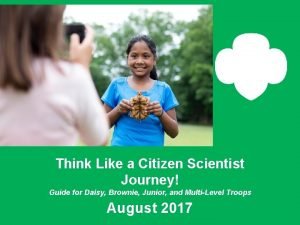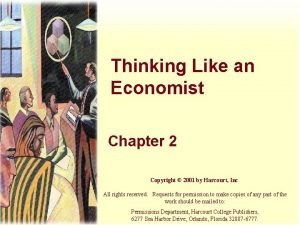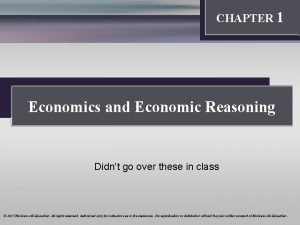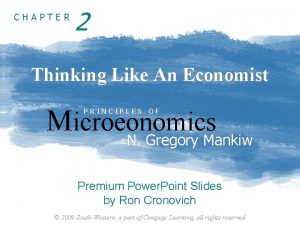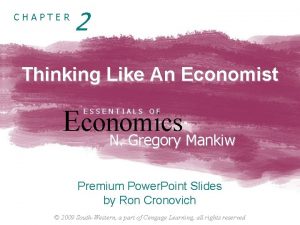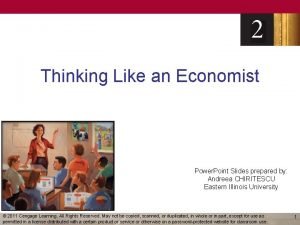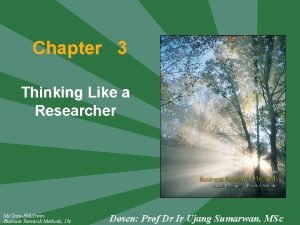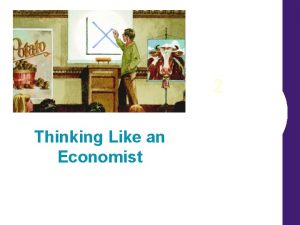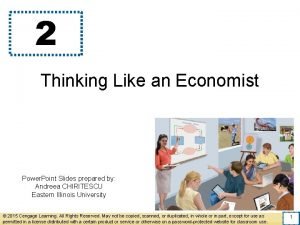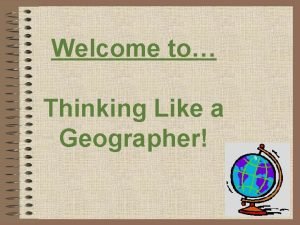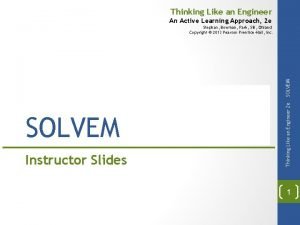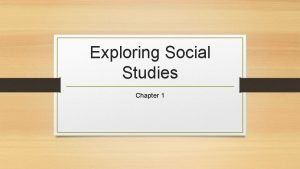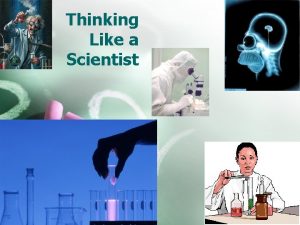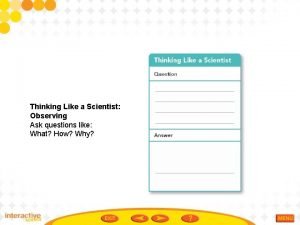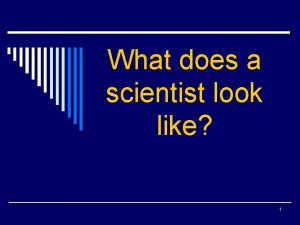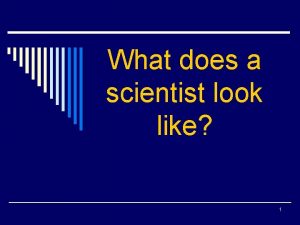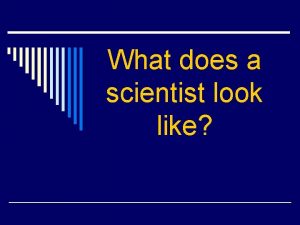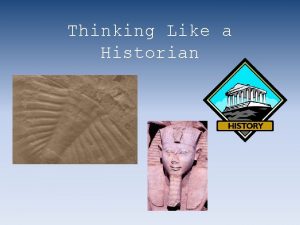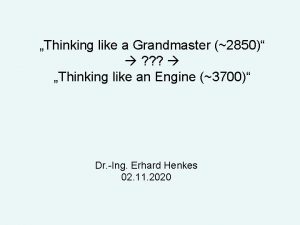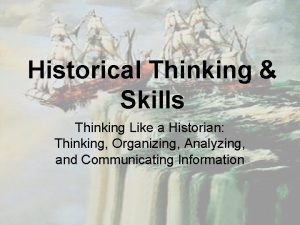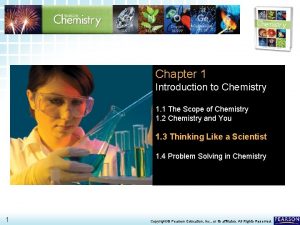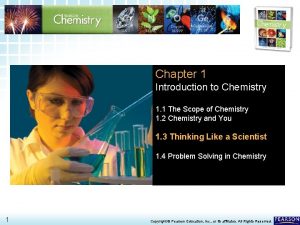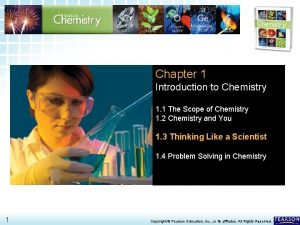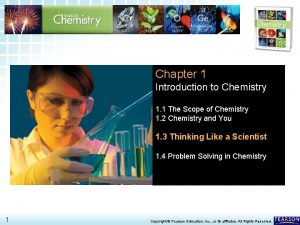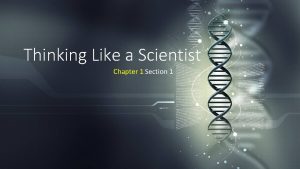1 3 Thinking Like a Scientist Chapter 1
















- Slides: 16

1. 3 Thinking Like a Scientist > Chapter 1 Introduction to Chemistry 1. 1 The Scope of Chemistry 1. 2 Chemistry and You 1. 3 Thinking Like a Scientist 1. 4 Problem Solving in Chemistry 1 Copyright © Pearson Education, Inc. , or its affiliates. All Rights Reserved.

1. 3 Thinking Like a Scientist > CHEMISTRY & YOU In 1928, Alexander Fleming, a Scottish scientist, noticed that the bacteria he was studying did not grow in the presence of a yellow-green mold. He thought the mold was killing the bacteria. How could Alexander Fleming tested his hypothesis? 2 Copyright © Pearson Education, Inc. , or its affiliates. All Rights Reserved.

1. 3 Thinking Like a Scientist > An Experimental Approach to Science The word chemistry comes from the word alchemy. • Alchemists were concerned with searching for a way to change other metals, such as lead, into gold. • Alchemists developed the tools and techniques for working with chemicals. • They designed equipment that is still in use today, including beakers, flasks, tongs, funnels, and the mortar and pestle. 3 Copyright © Pearson Education, Inc. , or its affiliates. All Rights Reserved.

1. 3 Thinking Like a Scientist > An Experimental Approach to Science How did Lavoisier help to transform chemistry? 4 Copyright © Pearson Education, Inc. , or its affiliates. All Rights Reserved.

1. 3 Thinking Like a Scientist > An Experimental Approach to Science Lavoisier helped to transform chemistry from a science of observation (qualitative) to the science of measurement (quantitative) that it is today. 5 Copyright © Pearson Education, Inc. , or its affiliates. All Rights Reserved.

1. 3 Thinking Like a Scientist > An Experimental Approach to Science Antoine-Laurent Lavoisier did work in the late 1700 s that revolutionized the science of chemistry. • He designed a balance that could measure mass to the nearest 0. 0005 gram. • He settled a long-standing debate that oxygen is required for a material to burn. 6 Copyright © Pearson Education, Inc. , or its affiliates. All Rights Reserved.

Who is credited with transforming chemistry from a science of observation to a science of measurement? A. Fleming B. Lavoisier C. de Mestral D. Carothers Copyright © Pearson Education, Inc. , or its affiliates. All Rights Reserved.

1. 3 Thinking Like a Scientist > The Scientific Method The scientific method is a logical, systematic approach to the solution of a scientific problem. * Chemists use the scientific method to solve problems and develop theories about the natural world. 8 Copyright © Pearson Education, Inc. , or its affiliates. All Rights Reserved.

1. 3 Thinking Like a Scientist > The Scientific Method What are the steps in the scientific method? 9 Copyright © Pearson Education, Inc. , or its affiliates. All Rights Reserved.

1. 3 Thinking Like a Scientist > The Scientific Method Steps in the scientific method include: 1. ) Question 2. ) Hypothesis 3. ) Test 4. ) Analyze Data 5. ) Conclusion 10 Copyright © Pearson Education, Inc. , or its affiliates. All Rights Reserved.

1. 3 Thinking Like a Scientist > The Scientific Method Making Observations What is the difference between an Observation and an Inference? • An observation is only what your senses tell you. • An inference takes what you observe and adds judgment to it. 11 Copyright © Pearson Education, Inc. , or its affiliates. All Rights Reserved.

1. 3 Thinking Like a Scientist > The Scientific Method Making Observations (Question) You try to start your car and you notice that it does not turn over while making a clicking sound. * You guess that the battery is dead. You are making a hypothesis. 12 Copyright © Pearson Education, Inc. , or its affiliates. All Rights Reserved.

1. 3 Thinking Like a Scientist > The Scientific Method Testing Hypotheses • A hypothesis is a proposed TESTABLE explanation for an observation. • Comes in an “IF” and “THEN” statement. example: IF this is true, THEN this should happen. 13 Copyright © Pearson Education, Inc. , or its affiliates. All Rights Reserved.

1. 3 Thinking Like a Scientist > The Scientific Method Testing Hypotheses Experiment, a organized procedure that is used to test a hypothesis. 1. ) charging the battery (just start with cables) 2. ) replacing the battery 14 Copyright © Pearson Education, Inc. , or its affiliates. All Rights Reserved.

1. 3 Thinking Like a Scientist > The Scientific Method Needed Parts of an Experiment Control 15 Constants • Your STANDARD of comparison. • Parts of the experiment that MUST NOT change. (what you compare your results too) (did you make a difference) (not having constants will cause your experiment to have more than 1 independent variable) Copyright © Pearson Education, Inc. , or its affiliates. All Rights Reserved.

1. 3 Thinking Like a Scientist > END OF 1. 3 16 Copyright © Pearson Education, Inc. , or its affiliates. All Rights Reserved.
 Think like a citizen scientist journey requirements
Think like a citizen scientist journey requirements Thinking like an economist chapter 2
Thinking like an economist chapter 2 Thinking like an economist chapter 1
Thinking like an economist chapter 1 Thinking like an economist chapter 2
Thinking like an economist chapter 2 Chapter 2 thinking like an economist summary
Chapter 2 thinking like an economist summary Thinking like an economist chapter 2
Thinking like an economist chapter 2 Positive thinking vs negative thinking examples
Positive thinking vs negative thinking examples Thinking about your own thinking
Thinking about your own thinking Holistic thinking example
Holistic thinking example Perbedaan critical thinking dan creative thinking
Perbedaan critical thinking dan creative thinking Thinking about you thinking about me
Thinking about you thinking about me Think like a researcher
Think like a researcher Thinking like an economist summary
Thinking like an economist summary Thinking like an economist ppt
Thinking like an economist ppt Whats relative location
Whats relative location Thinking like an engineer an active learning approach
Thinking like an engineer an active learning approach Exploring social studies lesson 1 thinking like a historian
Exploring social studies lesson 1 thinking like a historian
